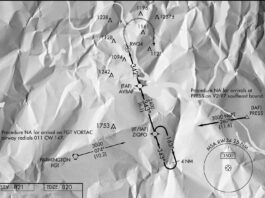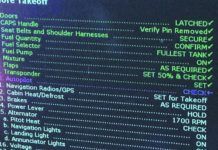IFR Briefing: November 2016
Air traffic controllers need better training to effectively assist aircraft in distress, the NTSB said in a safety-recommendation report released in September. In September, the FAA began offering a $500 rebate to aircraft owners who upgrade to ADS-B-capable avionics. New FAA rules that became effective in August make it easier for operators to secure a commercial drone certificate, and its expected their numbers will quickly outpace manned-aircraft pilots. NTSB staffers who investigated the ditching of USAir 1549 in the Hudson River in 2009 say the Hollywood movie about the event, Sully, portrays them in an inaccurate and unfair light.
Reader Feedback: November 2016
In the June issue, a reader had a question regarding the TERPZ FIVE departure at BWI. Your response in a lost com scenario was that you should climb to TERPZ at 11,000 then climb to your filed altitude after 10 minutes. I disagree. In the regs, 91.185 offers clear altitude guidance in a lost com situation. It is simply the highest of 3 altitudes-the altitude in your clearance, the altitude you were told to expect, and the highest IFR altitude. No mention is made about waiting for 10 minutes nor about a filed altitude.
Seeing Double
Instrument flight is a game of single degrees, so it should get your attention when numbers dont match. Were used to this when flying VOR radials with GPS. The magnetic declination of the VOR is infrequently updated, while GPS calculates it exactly from the latest data and the current location. This can be disconcerting on a VOR approach where the GPS youre using for situational awareness (or, the actual approach, now that you can) shows a course several degrees off from the chart.
Lower Won’t Work
While we usually train by flying right to minimums and then frequently flying the missed, how often in our actual flying do we miss and do it again, or divert to an alternate? How often do we get caught by surprise when the ceiling were expecting to break out of is lower than we thought (or lower than we need)? For those of us operating under 14 CFR Part 91, how often do we consider or actually find ourselves pushing the looser legal limits of landing under IFR?
Frankenstein Flight Approach
The RNAV (GPS) approach makes this a non-issue for pilots with GPS. This approach uses the Terminal Arrival Area (TAA) concept centered on TOPSY. Any arrival on a bearing to TOPSY from 326 degrees counterclockwise to 145 degrees simply crosses TOPSY at 2000 feet and continues inbound. In most of that area they can descend to 2000 feet 30 miles out, with a small segment over the Atlantic at 2100 feet. Cant be terrain out there; must be airspace.
When Air Traffic is Light, ATC Lets You Take Your Time Landing
Controllers cant just look where the traffic is now. Were mentally projecting every route ahead to see future conflicts. If Ive got two 120-knot aircraft at the same altitude converging on a point 20 miles away, in 10 minutes theyll be waving to each other. Something-like an altitude change-must be done in 10 minutes. If I need to use immediately in that altitude clearance, I screwed up by waiting way too long.
A Change of Seasons
The most immediate change that meteorologists and pilots see in the weather pattern is an increase in the tropospheric flow across the United States and southern Canada at all levels. This starts in earnest in September and continues through October. Temperatures decrease rapidly in the polar regions as fall progresses, dramatically strengthening temperature contrasts between high latitudes and the tropics. This enhances the jet stream pattern and surface patterns alike. So across the board we see an increase in clear air and mechanical turbulence everywhere.
Not Quite an ILS
Among these procedures youll find a surprising variety of features. But here are the common threads: The LDA is made up of a localizer transmitting a course signal with the expected beam width of three to six degrees, but it will be offset by as much as 30 degrees, even when advertised with a specific runway.
On the Air: October 2016
I got the dreaded write down this number to call the FAA last week. We were flying into Lancaster, south of Dallas, for breakfast. After taking off from my local airport in a V-tail Bonanza in VFR conditions, the predicted scattered clouds at Lancaster turned out to be a low overcast. We were on VFR flight following, so I called DFW approach and got a pop up IFR clearance to shoot the GPS 31 approach. About the time we reached the FAF, we got the call to copy down a phone number.
Deflated Ego
A few months back I admitted here that Id not flown in a year, but was correcting that shortcoming. My ego told me I was a retired airline pilot with many thousands of hours, who had been flying over 75 hours a month, so returning would be no big deal and Id easily do it. The editor in me considered the more responsible, conservative and methodical approach I would espouse in writing. Fortunately, the more conservative path won out.
Readback: October 2016
The minimum vectoring altitude near my home drome is about 3000 feet MSL because of our distance from the radar site. Thats higher than the 2000-foot crossing at the FAFs so we always get cleared for a full approach. However, our ADS-B reception is currently around 1000 feet MSL/700 AGL. After 2020, when the traffic picture is nearly full via ADS-B and closer to the ground, do you foresee MVAs being lowered in areas that have been limited primarily by poor radar coverage?
Change Your Checklist
Checklists get taken for granted-settle into your seat in the cockpit, pull out the booklet or laminated cards, turn to the Before Engine Start page and start following the steps. Fire up the engine(s) and proceed down to After Engine Start and Before Taxi. Sound familiar? For most flying under 14 CFR Part 91, this read-then-do routine is the norm all the way to Parking and Securing. While many pilots with a fair amount of experience-particularly those with their own aircraft-will often go a step beyond and make their own checklists, there are far more efficient methods to get things done on time and in the proper order.












